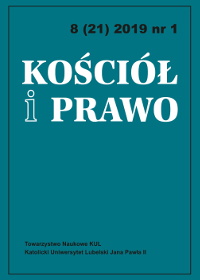Processus brevior coram Episcopo – a Complete Novelty?
Abstract
The establishment of the processus matrimonialis brevior coram Episcopo is a significant change introduced by Pope Francis’ motu proprio Mitis Iudex Dominus Iesus, which is a complete novelty in relation to the legislation in force until recently. This is a special type of marriage annulment proceedings that may apply in cases where the request was made by both spouses or by one of them with the consent of the other and is supported by particularly obvious arguments. In addition to the speed and simplification of the procedure, this process demonstrates the special care and vigilance of the diocesan bishop in relation to his faithful who are concerned about their marital status.An abbreviated process held before a bishop, while constituting a significant novelty in relation to the legislation in force in 2015, is deeply rooted in the canonical tradition, dating back to the first centuries of Christianity.The author first presents the ancient institution of episcopalis audientia, introduced by Emperor Constantine’s edict, sustained by imperial legislation; then the judicial authority of the medieval bishop is discussed (showing that the evolution of the justice system, under which officials emerged, did not exclude in any way the personal exercise of jurisdiction by a bishop), and finally the bishop is presented as a judge in the period from the Council of Trent to CIC/83.The extraordinary nature of the abbreviated trial before a bishop implies, on the one hand, a far-reaching simplification of the procedure, and on the other hand, indicates the central role of the bishop in judicial ministry which he performs as the supreme judge in his particular Church. The abbreviated marital process before a bishop is more like a return to antiquity than an absolute novelty. There is a significant analogy between the ancient institutions of episcopalis audientia and processus brevior. Pope Francis did not merely want to harmonize other methods of exercising potestas iudicandi (in the case of obvious invalidity of marriage) with the already existing procedures, but first of all to restore a more authentic and profound meaning of the mission of the diocesan bishop.
References
Astigueta, Damian G. 2017. “Riflessioni a proposito della natura giuridica del processo più breve.” Periodica 106, no. 1:29-56.
Becciu, Giovanni Angelo. 2015. “Il vescovo giudice nella riforma di Papa Francesco. Prolusione in ocasione dell’Anno accademico di inizio attività 2015-2016 dello Studio Rotale.” L’Osservatore Romano (4 novembre): 1-2.
Belfiore, Gianluca. 2017. I processi di nullità matrimoniale nella reforma di papa Francesco. Catania: Edizioni Grafiser-Troina.
Bernardo, Elena. 2017. “Problemi e criticità della nuova procedura.” In La riforma del processo matrimoniale ad un anno dal Motu proprio „Mitis Iudex Dominus Iesus”, ed. Lucia Musso, and Carlo Fusco, 109-52. Città del Vaticano: Libreria Editrice Vaticana.
Bianchi Riva, Raffaella. 2017. “Il giudice e la misericordia. Riflessioni sull’ amministrazione della giustizia nel diritto canonico classico. Intervento presentato al II Congresso Internazionale, Cattedra Innocenzo III.” Justice Mercy and Law. From revenge to forgiveness in the History of Law 5:186-219.
Condorelli, Orazio. 1997. Ordinare – iudicare. Ricerche sulla potestà dei vescovi nella Chiesa antica e altomedievale (secoli I-II). Roma: Il Cigno GG Edizioni.
Da Trani, Goffredo. 1605. Summa super titulis Decretalium. De divortiis. Venetiis: Brixiae.
Daniel, Wiliam L. 2015. “An Analysis of Pape Francis 2015 Reform of the General Legislation Governing Nullity of Marriage.” The Jurist 75:429-66.
Del Pozzo, Massimo. 2016. Il processo matrimoniale più breve davanti al vescovo. Roma: Edizioni Santa Croce.
Del Pozzo, Massimo. 2017. “L’impatto della riforma sul diritto processuale vigente.” In La riforma del processo matrimoniale ad un anno dal Motu proprio «Mitis Iudex Dominus Iesus», ed. Lucia Musso, and Carlo Fusco, 47-80. Città del Vaticano: Libreria Editrice Vaticana.
Del Pozzo, Massimo. 2018. “Chiarimenti pontifici sul «processus brevior». Riflessioni alla luce del Discorso del 25 novembre 2017.” Ius Canonicum 58, no. 16:503-37.
Fantappiè, Carlo. 2011. Storia del diritto canonico e delle istituzioni della Chiesa. Bologna: Il Mulino.
Góralski, Wojciech. 1984. „Statuty synodalne legata Jakuba z Leodium.” Prawo Kanoniczne 27, nr 3-4:149-71.
Góralski, Wojciech. 2012. „«Lex agendi – lex credendi». O właściwą interpretację prawa kanonicznego. Przemówienie Benedykta XVI do Roty Rzymskiej z 1 stycznia 2012 roku.” Ius Matrimoniale 17 (23): 113-23.
Góralski, Wojciech. 2017. Proces małżeński skrócony przed biskupem. Płock: Płocki Instytut Wydawniczy.
Grzywacz, Jerzy. 1983. „Episcopalis audientia.” W Encyklopedia Katolicka, t. 4, red. Romuald Łukaszyk, Ludomir Bieńkowski, i Feliks Gryglewicz, 1035. Lublin: Towarzystwo Naukowe KUL.
Hemperek, Piotr. 1974. Oficjalat okręgowy w Lublinie XV-XVIII w. Lublin: Redakcja Wydawnictw KUL.
Hilling, Nicolaus. 1911. Die offiziale der Bischöfe von Halberstadt im Mittelalter. Kirchenrechtliche Abhandlungen herausgegeben von U. Stutz. Heft 72. Stuttgart: Verlag von Ferdinand Enke.
Hinschius, Paul. 1878. System des katholischen Kirchenrechts. Ed. 2. Berlin: German.
Llobell, Joaquin. 1989. La prórroga de la competencia y el fuero del actor en el proceso matrimonial canónico. Roma: Edizioni Santa Croce.
Plöchl, Willibald M. 1963a. Storia del diritto canonico. Vol. 1, Dalle origini allo scisma del 1054. Milano: Massimo.
Plöchl, Willibald M. 1963b. Storia del diritto canonico. Vol. 2, Il diritto canonico della civiltà occidentale 1055-1517. Milano: Massimo.
Rabino, Giorgio. 2017. “Ipse Episcopus iudex: ritorno alla tradizione canonica?.” Stato, Chiese e pluralismo confessionale 26:1-43. https://www. statochiese.it [dostęp: 15.04.2019].
Roberti, Franciscus. 1956. De processibus. Vol. 1. Città del Vaticano: Libreria Editrice Vaticana.
Salerno, Francesco. 1994. “Precedenti medievali del processo matrimoniale canonico.” In Processo matrimoniale canonico, ed. Pietro A. Bonnet, 27-100. Città del Vaticano: Libreria Editrice Vaticana.
Tigano, Marta, and Mariangela Galluccio. 2019. “Novità processuali in materia di nullità matrimoniale e giurisdizione canonica.” Stato, Chiese e pluralismo confessionale 13:1-30. https://www.statochiese.it [dostęp: 15.04.2019].
Van Espen, Bernhard. 1776. Ius ecclesiasticum universum. Vol. 4. Neapoli: Antonio Grazio.
Vismara, Giulio. 1937. Episcopalis audientia: l’attività giurisdizionale del vescovo per la risoluzione delle controversie pivate tra i laici nel diritto romano e nella storia del diritto italiano fino al secolo nono. Milano: Vita e Pensiero.
Copyright (c) 2019 Kościół i Prawo

This work is licensed under a Creative Commons Attribution-NonCommercial-NoDerivatives 4.0 International License.





